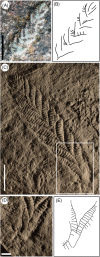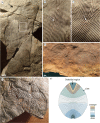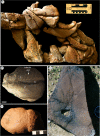Ediacaran developmental biology
- PMID: 29105292
- PMCID: PMC5947158
- DOI: 10.1111/brv.12379
Ediacaran developmental biology
Abstract
Rocks of the Ediacaran System (635-541 Ma) preserve fossil evidence of some of the earliest complex macroscopic organisms, many of which have been interpreted as animals. However, the unusual morphologies of some of these organisms have made it difficult to resolve their biological relationships to modern metazoan groups. Alternative competing phylogenetic interpretations have been proposed for Ediacaran taxa, including algae, fungi, lichens, rhizoid protists, and even an extinct higher-order group (Vendobionta). If a metazoan affinity can be demonstrated for these organisms, as advocated by many researchers, they could prove informative in debates concerning the evolution of the metazoan body axis, the making and breaking of axial symmetries, and the appearance of a metameric body plan. Attempts to decipher members of the enigmatic Ediacaran macrobiota have largely involved study of morphology: comparative analysis of their developmental phases has received little attention. Here we present what is known of ontogeny across the three iconic Ediacaran taxa Charnia masoni, Dickinsonia costata and Pteridinium simplex, together with new ontogenetic data and insights. We use these data and interpretations to re-evaluate the phylogenetic position of the broader Ediacaran morphogroups to which these taxa are considered to belong (rangeomorphs, dickinsoniomorphs and erniettomorphs). We conclude, based on the available evidence, that the affinities of the rangeomorphs and the dickinsoniomorphs lie within Metazoa.
Keywords: Bilateria; Ediacaran; Eumetazoa; Metazoa; development; evolution.
© 2017 The Authors. Biological Reviews published by John Wiley & Sons Ltd on behalf of Cambridge Philosophical Society.
Figures







References
-
- Anderson, D. T. (1973). Onychophorans In Embryology and Phylogeny in Annelids and Arthropods (eds Anderson D. T. and Kerkut G. A.), pp. 93–126. Elsevier, Oxford, UK.
-
- Antcliffe, J. B. & Brasier, M. D. (2007). Charnia and sea pens are poles apart. Journal of the Geological Society, London 164, 49–51.
-
- Antcliffe, J. B. & Brasier, M. D. (2008). Charnia at 50: developmental models for Ediacaran fronds. Palaeontology 51, 11–26.
-
- Bamforth, E. L. , Narbonne, G. M. & Anderson, M. M. (2008). Growth and ecology of a multi‐branched Ediacaran rangeomorph from the Mistaken Point assemblage, Newfoundland. Journal of Paleontology 82(4), 763–777.
-
- Berking, S. (2006). Principles of branch formation and branch patterning in Hydrozoa. International Journal of Developmental Biology 50, 123–134. - PubMed
Publication types
MeSH terms
Grants and funding
LinkOut - more resources
Full Text Sources
Other Literature Sources

